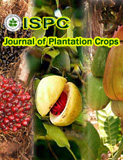Genetic diversity of Libyan date palms cultivars using amplified fragment length polymorphism and biochemical analysis
DOI:
https://doi.org/10.25081/jpc.2022.v50.i1.7387Abstract
Phoenix dactylifera L. is a flowering plant species commonly known as the date palm and is widely cultivated in most Middle East countries, including Libya. The present study analysed the biochemical and genetic diversity of fully mature eight Libyan date palm cultivars grown in different regions using the amplified fragments length polymorphism (AFLP) technique. Six pairs of AFLP molecular marker combinations were utilised to discriminate the eight date palm genotypes. Fruit dimensions (length x diameter) varied based on the type; Majhool Alheelo fruit had the highest value (15.29 cm2), while the lowest value was for Alkhadraya fruits (7.9 cm2). Reducing sugar content ranged from 10.4 per cent of flesh dry weight in Umfetity cultivars to 61.2 per cent in Sufeer-genab, which also showed the highest polymorphism percentage (P%=4.9), while Alkhadarya was the lowest (P%=0.519). The phylogenetic tree indicated that the most distantly related cultivars were Sufeer-genab, Alhamraya and Majhool Alhelo. The two most closely related cultivars were the Alsaeedy Show and Alkhadarya, grown in different regions. Our results indicate that the nutritional and genetic diversity of Libyan cultivars is not closely matched with the growing region.
Downloads
References
Al-Alawi, R.A., Al-Mashiqri, J.H., Al-Nadabi, J.S., Al-Shihi, B.I. and Baqi, Y. 2017. Date palm tree (Phoenix dactylifera L.): Natural products and therapeutic options. Frontiers in Plant Science 8: 845.
Al-Tamim, E.A.A., 2014. Comparative study on the chemical composition of Saudi Sukkari and Egyptian Swei date palm fruits. The Journal of American Science 10(6): 149-153.
Aljaloud, S., Colleran, H.L. and Ibrahim, S.A. 2020. Nutritional value of date fruits and potential use in nutritional bars for athletes. Food and Nutrition Sciences 11(06): 463.
Altaheri, H., Alsulaiman, M. and Muhammad, G. 2019. Date fruit classification for robotic harvesting in a natural environment using deep learning. IEEE Access 7, 117115-117133.
Azim, M.K. 2021. Date Palm (Phoenix dactylifera L.) Chloroplast Genome, In: The Date Palm Genome, Vol. 1. Springer, pp. 201-209.
Becker, J., Vos, P., Kuiper, M., Salamini, F. and Heun, M. 1995. Combined mapping of AFLP and RFLP markers in barley. Molecular and General Genetics 249(1): 65-73.
Benmeziane-Derradji, F. 2019. Nutritional value, phytochemical composition, and biological activities of Middle Eastern and North African date fruit: an overview. Euro-Mediterranean Journal for Environmental Integration 4(1): 1-11.
Besbes, S., Blecker, C., Deroanne, C., Lognay, G., Drira, N., Attia, H. 2004. Quality characteristics and oxidative stability of date seed oil during storage. Food Science And Technology International 10(5): 333-338.
Booij, I., Piombo, G., Risterucci, A.-M., Coupe, M., Thomas, D. and Ferry, M. 1992. Etude de la composition chimique de dattes à différents stades de maturité pour la caractérisation variétale de divers cultivars de palmier dattier (Phoenix dactylifera L.). Fruits 47(6): 667-678.
De Nicola, E., Gallo, M., Iaccarino, M., Meriç, S., Oral, R., Russo, T., Sorrentino, T., Tünay, O., Vuttariello, E. and Warnau, M. 2004. Hormetic versus toxic effects ofvegetable tannin in a multitest study. Archives of Environmental Contamination and Toxicology 46(3): 336-344.
El-Demerdash, E.-S.S., Elsherbeny, E.A., Salama, Y.A.M. and Ahmed, M.Z. 2019. Genetic diversity analysis of some Egyptian Origanum and Thymus species using AFLP markers. Journal of Genetic Engineering and Biotechnology 17(1): 1-11.
El Kadri, N., Mimoun, M.B. and Hormaza, J.I. 2019. Genetic diversity of Tunisian male date palm (Phoenix dactylifera L.) genotypes using morphological descriptors and molecular markers. Scientia Horticulturae 253: 24-34.
Gawel, N. and Jarret, R. 1991. A modified CTAB DNA extraction procedure for Musa and Ipomoea. Plant Molecular Biology Reporter 9(3): 262-266.
Huda, M.N., Hasan, M., Abdullah, H.M. and Sarker, U. 2019. Spatial distribution and genetic diversity of wild date palm (Phoenix sylvestris) growing in coastal Bangladesh. Tree Genetics and Genomes 15(1): 1-11.
Maqsood, S., Adiamo, O., Ahmad, M. and Mudgil, P. 2020. Bioactive compounds from date fruit and seed as potential nutraceutical and functional food ingredients. Food Chemistry 308:125522.
Moussouni, S., Pintaud, J.-C., Vigouroux, Y. and Bouguedoura, N. 2017. Diversity of Algerian oases date palm (Phoenix dactylifera L., Arecaceae): Heterozygote excess and cryptic structure suggest farmer management had a major impact on diversity. PloS one 12(4): e0175232.
Racchi, M.L. and Camussi, A. 2018. The date palms of Al Jufrah-Libya: a survey on genetic diversity of local varieties. Journal of Agriculture and Environment for International Development (JAEID) 112(1): 161-184.
Restrepo, C.M., Llanes, A. and Lleonart, R. 2018. Use of AFLP for the study of eukaryotic pathogens affecting humans. Infection, Genetics and Evolution 63: 360-369.
Siddiqi, S.A., Rahman, S., Khan, M.M., Rafiq, S., Inayat, A., Khurram, M.S., Seerangurayar, T. and Jamil, F. 2020. Potential of dates (Phoenix dactylifera L.) as natural antioxidant source and functional food for healthy diet. Science of the Total Environment 748: 141234.
Zargar, M., Romanova, E., Trifonova, A., Shmelkova, E. and Kezimana, P. 2017. AFLP-analysis of genetic diversity in soybean [Glycine max (l.) Merr.] cultivars Russian and foreign selection. Agronomy Research 15(5): 2217–2225.
Zhao, J., Li, T., Xu, Z., Wang, Z., Yang, S. and Chen, A. 2018. AFLP markers for meat traceability of cattle in the Chinese market. Food Control 91: 421-426.
Published
How to Cite
Issue
Section
Copyright (c) 2022 Journal of Plantation Crops

This work is licensed under a Creative Commons Attribution 4.0 International License.







 .
.